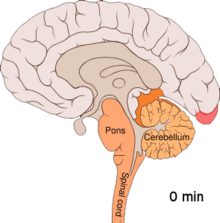User:ChaoticBeast/sandbox
| Migraine | |
|---|---|
 | |
| Migraine | |
| Specialty | Neurology |
| Symptoms | Headaches, nausea, sensitivity to light, sensitivity to sound, sensitivity to smell |
| Usual onset | Around puberty |
| Duration | Recurrent, long term |
| Causes | Drinks, Stress, Sensory stimuli, Sleep changes, Physical factors, Weather changes, Medications, Foods, Food additives |
| Risk factors | Family history, female |
| Prevention | Metoprolol, valproate, topiramate |
| Medication | Opioid medications, Anti-nausea drugs, Antidepressants, Anti-seizure drugs, Botox injections, Triptans |
| Frequency | 12.6% |
Overview[edit]
A migraine can cause severe throbbing pain or a pulsing sensation, usually on one side of the head. It can also include visual disturbances, such as flashes of light or blind spots, or other disturbances, such as tingling on one side of the face or in an arm or leg and difficulty speaking.
Symptoms[edit]
Migraines, which often begin in childhood, adolescence or early adulthood, can progress through four stages: prodrome, aura, attack and post-drome. After a migraine attack, an individual might feel drained, confused and washed out for up to a day.
Causes[edit]
Though migraine causes aren't fully understood, genetics and environmental factors appear to play a role. Changes in the brainstem and its interactions with the trigeminal nerve, a major pain pathway, might be involved. Certain neurotransmitters play a role in the pain of migraine, including calcitonin gene-related peptide (CGRP). There are a number of migraine triggers, including Hormonal changes in women. Hormonal medications, such as oral contraceptives and hormone replacement therapy, also can worsen migraines. Some women, however, find their migraines occurring less often when taking these medications. Bright lights and sun glare can induce migraines, as can loud sounds. Strong smells including perfume, paint thinner, secondhand smoke and others trigger migraines in some people. Missing sleep, getting too much sleep or jet lag can trigger migraines in some people. Intense physical exertion, including sexual activity, might provoke migraines. Oral contraceptives and vasodilators, such as nitroglycerin, can aggravate migraines. The causes also include the sweetener aspartame and the preservative monosodium glutamate (MSG), found in many foods.
Risk factors[edit]
Several factors make a person more prone to having migraines, including Family history. Migraines can begin at any age, though the first often occurs during adolescence. Migraines tend to peak during the 30s and gradually become less severe and less frequent in the following decades. For women who have migraines, headaches might begin just before or shortly after the onset of menstruation.
Diagnosis[edit]
MRI scans help doctors diagnose tumors, strokes, bleeding in the brain, infections, and other brain and nervous system (neurological) conditions. This in turn assists doctors to diagnose possible medical problems that may be causing migraine headaches.
Treatment[edit]
The treatment choices depend on the frequency and severity of the headaches, whether an individual has nausea and vomiting with the headaches, how disabling the headaches are, and other medical conditions one has. Also known as an acute or abortive treatment, medicational drugs are taken during migraine attacks and are designed to stop symptoms.
Remedies[edit]
Regular exercise can also help one lose weight or maintain a healthy body weight, as obesity is thought to be a factor in migraines. Biofeedback and other forms of relaxation training teach ways to deal with stressful situations, which might help reduce the number of migraines one has.
Medication[edit]
Migraine relief medications that combine caffeine, aspirin and acetaminophen (Excedrin Migraine) may be helpful, but usually only against mild migraine pain. Available as a nasal spray or injection, these are most effective when taken shortly after the start of migraine symptoms for migraines that tend to last longer than 24 hours. When taken too long, these might cause medication-overuse headaches, and possibly ulcers and bleeding in the gastrointestinal tract.

